Spoliation Advisory Panel Newsletter - December 2023, No.17
Published 28 February 2024
A message from Lord Parkinson of Whitley Bay, Parliamentary Under Secretary of State for Arts and Heritage and DCMS Lords Minister, UK Government
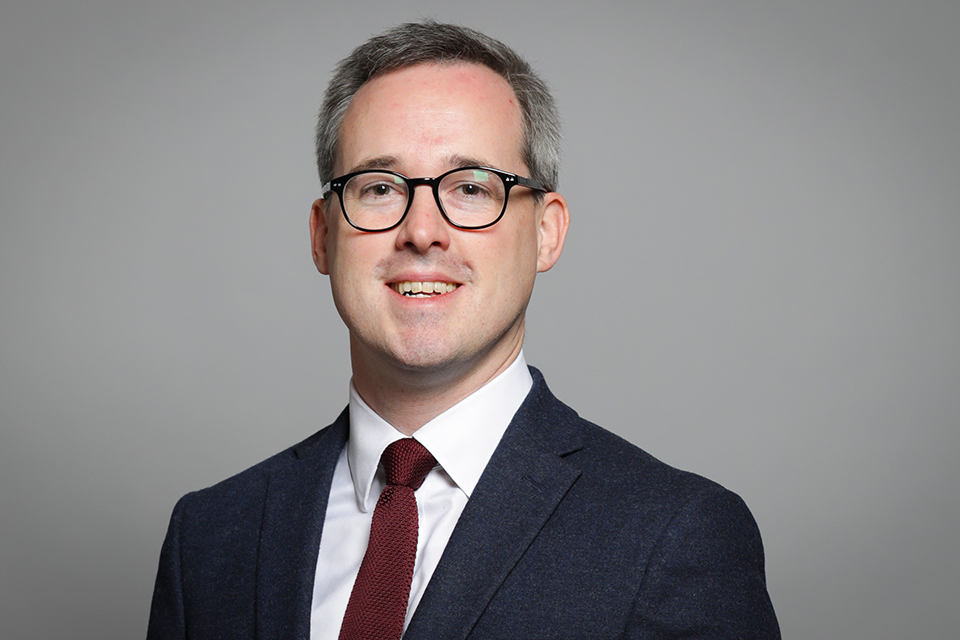
This is the first edition of the newsletter of the Network of European Restitution Committees on Nazi-looted Art under the UK’s presidency.
Six years ago, in September 2017, more than 300 delegates from around the world attended a conference at the National Gallery in London, seeking to intensify efforts to identify and return Nazi-looted art. One of the themes which emerged from that conference was that there was much duplication of effort, particularly in the field of research, and that the improved sharing of information and ideas between everyone involved in this important work could make a positive difference at little cost. The Network, to which the UK is privileged to play host during 2023–24, was the natural culmination of that thinking.
Compared to other European countries, very little looted art found its way to the UK during and after the end of the Second World War. Of course, economy of scale should never be an excuse for economy of action. Guided by the Washington Principles, national museum directors across the UK established a working group in 1998 to examine issues relating to the spoliation of art during the Third Reich and to draw up their own statement of principles and proposed actions for member institutions, including the collation of information relating to provenance during that period of objects which are now held in museum collections.
Since then, our national museums have undertaken detailed research of their collections to identify objects with uncertain provenance between the years 1933 and 1945. This research is held on an online database which is actively maintained by editors from the contributing UK museums and available to the public across the world.
This work was complemented in 2000 when HM Government established the Spoliation Advisory Panel to consider claims from anyone who had lost possession of a cultural object during the Nazi period and where the item is now in a UK collection. In 2009, we also introduced important legislation in this area to allow national museums to return Nazi- looted art where this follows a recommendation by the Panel and where Ministers agree. In 2019, the legislation was amended to remove a ten-year limit for the bringing forward of claims so that this important work can continue for as long as it takes.
Now in their fifth year, these newsletters have become an established source of information in this important area and they are widely read by museums, researchers, policy-makers and many others. I hope that they may also act as a guide for other countries who are seeking to do more in this area. The UK is the fifth country to hold the presidency of the Network; five years in is, I hope, a good time to take stock of the current set-up and to consider the future direction of the group – we look forward to having those conversations over the course of the year.
Lord Parkinson of Whitley Bay
Minister for Arts & Heritage
Department for Culture, Media & Sport
Introduction by The Right Honourable Sir Donnell Deeny, Chairman of the Spoliation Advisory Panel

The idea of a European network of restitution committees was first discussed at a dinner hosted by the Dutch Restitutions Committee at the Mauritshuis Royal Picture Gallery, prior to an international symposium on “Fair and Just Solutions” in November 2012.
This seemed a somewhat ambitious step at the time. Whilst the committees undeniably shared a common purpose, they operated under different laws and terms of reference and different historical backgrounds. It was not until 2017, at the London Spoliation Conference, that the proposal was once again thrust into the limelight and became a key recommendation in the Conference Action Plan. Finally, in 2019, the Network was officially launched and the Presidency of the Network has rotated between the five committees.
The Network has certainly proved its worth over the last four years and has increased cooperation and information sharing between the committees. Its newsletters are widely read and of interest to a wide range of people both those who are directly involved in the work and those with a more general interest. The forging of closer ties between the committees has been beneficial in a number of ways. Earlier this year, the Spoliation Advisory Panel published a report recommending the restitution of a work by Gustave Courbet in the possession of the Fitzwilliam Museum, Cambridge. The claim threw up some tricky issues concerning French inheritance law and there were concerning gaps in the provenance of the work prior to its seizure.
The Commission for the Compensation of Victims of Spoliation (France) was able to provide the Panel with expert advice on these issues which assisted it in its decision making. The Spoliation Advisory Panel was grateful for this assistance which is a great example of collaborative working enhanced by our membership of the Network.
I look forward to the year ahead. I hope that we may do more to assist other countries who are exploring these issues through the dissemination of good practice and begin the process of thinking how we would want the Network to evolve now that each country has hosted the Presidency.
In the meantime, I hope you enjoy the articles in this newsletter.
The Right Honourable Sir Donnell Deeny
Chairman of the Spoliation Advisory Panel
News: France
The Commission for the Compensation of Victims of Spoliation (CIVS) welcomes its new director.
Since 1 June 2023, Gilles Bon-Maury has been at the head of the CIVS succeeding Jérôme Bénézech, who stepped down on 31 March 2023.
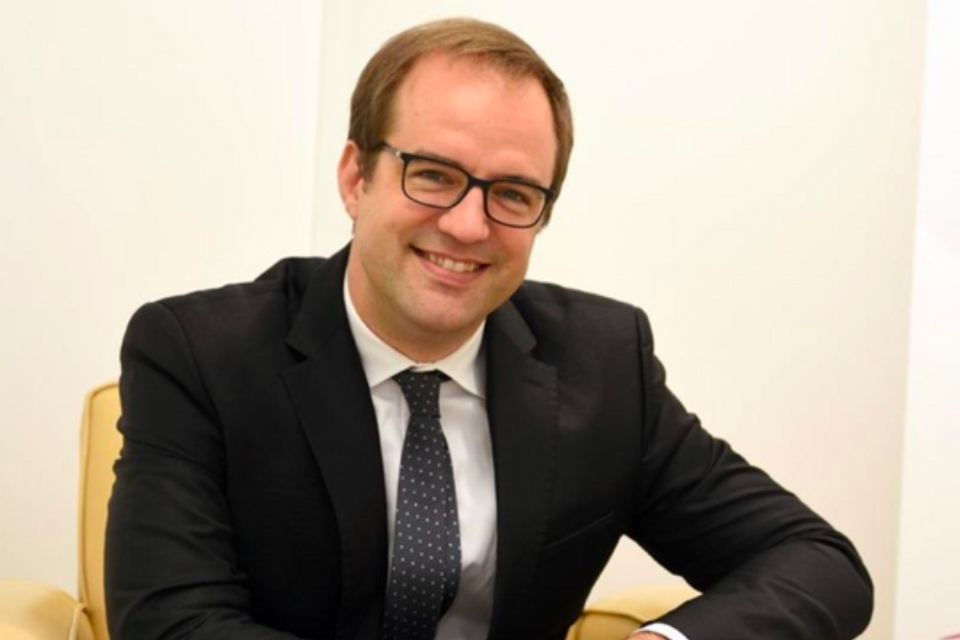
Before joining the CIVS, M. Bon-Maury was permanent secretary of the RSE - Platform for Corporate Social Responsibility - at France Strategie which is an independent institution reporting to the Prime Minister.
Previously, he held communication posts in the departments responsible for State reform and in the Prime Minister’s Department of Administrative and Financial Services. He was then appointed to the office of the Mayor of Reims, then to the office of the Minister for Women’s Rights.
Publication of the 2022 CIVS Activity Report
The CIVS activity report has been published and can be downloaded online in English, German and French. Since its complete redesign last year, the CIVS 2022 report takes up the 3 pillars of the Commission’s missions, which are: Compensation, Restitution and Remembrance.
The year 2022 was marked, among other things, by the renewal in April of the four qualified persons within the Deliberative panel (initially appointed in May 2019), but also by a structural change with a new decree limiting the term of office of magistrates in order to better adjust the capacity to investigate cases.
The increase in the number of tasks, to seven last year, also marks a change in competencies in this area and the confrontation of new difficulties, all of which are dealt with on a case- by-case basis.
Lastly, the year 2022 once again provided an opportunity to combine the Commission’s legal action with the duty of remembrance. This time, the Franco-German angle was particularly highlighted.
If you would like to find out more about CIVs missions and the outcome of 2022, download the latest report.
News: Netherlands
Painting Landscape with a Waterfall is returned to Gosschalk’s heirs
Research conducted by the NIOD Expert Centre Restitution, at the request of the Dutch Restitutions Committee, has resulted in the return of the painting Landscape with a Waterfall by the artist Jacques d’Arthois to the heirs of Joseph Henri Gosschalk (1875-1952). The work has been in the collection of the Museum aan het Vrijthof Foundation since 1958.
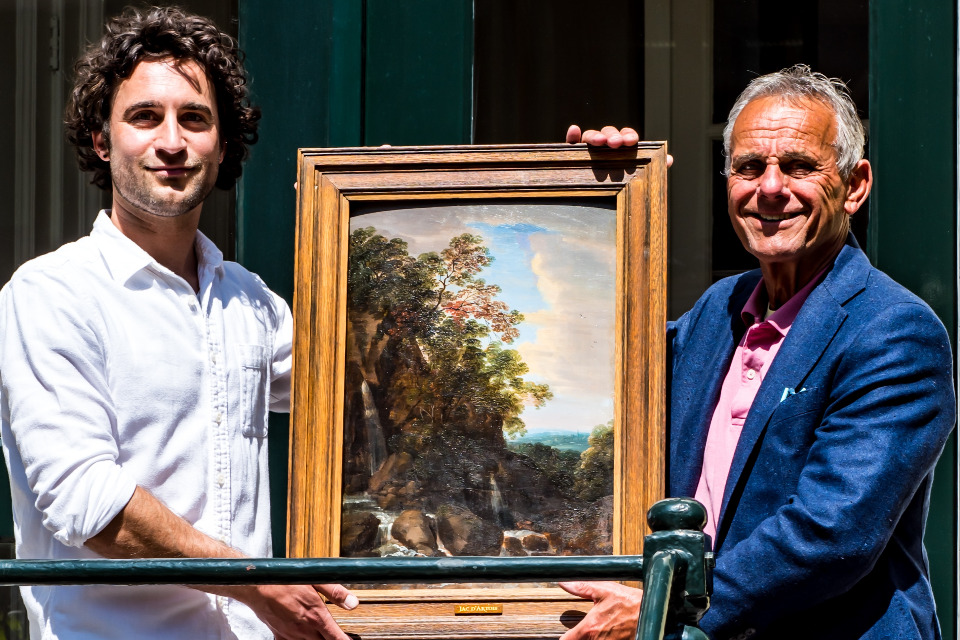
Gosschalk heirs holding the painting Landscape with a waterfall by Jacques d’Arthois (photo Restitutiecommissie)
Research revealed that it is highly plausible that the painting had belonged to Gosschalk. It is not clear whether the painting ceased to be in his possession before or after the German invasion of the Netherlands. The Museum aan het Vrijthof Foundation has declared that it is willing to restitute the painting on the assumption that Gosschalk had to sell it in difficult circumstances around the time of the German invasion.
The Restitutions Committee has recorded the settlement in a binding opinion. The Foundation returned the painting to the heirs.
Appointment of New Chair and Committee Member for the Dutch Restitutions Committee
The Dutch State Secretary for Culture and Media has appointed Professor A.I.M. (Toon) van Mierlo as of 15 August 2023 as the new Chair of the Restitutions Committee and Professor C.J.H. (Corjo) Jansen as of 1 September 2023 as a new Committee Member.
The RC is pleased that both members are joining the Committee and looks forward to fruitful collaboration.
Restitution Committee (RC) Members
Professor Toon van Mierlo (Chair)
Dick Oostinga (Vice-Chair)
Dr Jaap Cohen
Dr Saskia Cohen-Willner
Professor Corjo Jansen
Dr Jan van Kreveld
Dr Claartje Wesselink
Press Release: Ministry of Education, Culture & Science Announcement: Netherlands Government Gazette
Byzantine ivory relief returns to heirs of partners of Kunsthaus A.S. Drey
The Restitutions Committee has advised Rotterdam City Council to restitute the ivory relief Hodegetria or Virgin and Child, which is in Museum Boijmans Van Beuningen, to the heirs of the partners of Kunsthaus A.S. Drey.

Ivory relief Hodegetria or Virgin and Child. (photo: Museum Boijmans Van Beuningen)
Research by the Expert Centre Restitution (ECR) showed it is highly likely that this artwork came from the collection of the A.S. Drey art gallery in Munich, which until 1936 was in the hands of the German-Jewish Drey family. It also became sufficiently plausible that the sale of the artwork in 1936 was involuntary as a result of circumstances directly connected with the Nazi regime.
Rotterdam City Council has concurred with the Restitutions Committee’s binding opinion and will restitute the artwork to the heirs of the partners of Kunsthaus A.S. Drey.
News: Austria
The Commission for Provenance Research on a visit to the Museum of Military History/Military History Institute
The Austrian Commission for Provenance Research is currently undertaking provenance research in twelve federal and two semi-federal museums and collections. In order to strengthen the connection to the individual institutions and the mutual exchange, it organizes excursions to these at irregular intervals and occasionally holds its work meetings at these institutions.
Dr. Georg Hoffmann, director of the Museum of Military History/Military History Institute (HGM/MHI) since February 2023, invited the Commission to visit the museum in order to stimulate professional exchange and to emphasize his interest in close and trusting cooperation. As a contemporary historian who has researched, among other things, Nazi crimes and military war crimes, the promotion of provenance research on Nazi-looted art is of particular importance to him.
Provenance research has been carried out at the HGM/MHI within the framework of the Commission for Provenance Research since April 1998. Since then, dossiers and reports on 14 different collections and collectors have been submitted there, on the basis of which the Art Restitution Advisory Board has been able to issue restitution recommendations for more than 1,000 individual objects. Nevertheless, major challenges still exist in the area of systematic provenance research: The collections of the HGM/MHI are characterized by a particular diversity of objects, ranging from photographs and pamphlets to uniforms, weapons, medals, vehicles and oil paintings, among others. In addition, provenance research is confronted with a vast number of objects. From 1938 to 1945 alone, more than 20,000 objects were newly entered into the inventories, including more than 3,600 works of art.
Especially since some members of the Commission had had only fleeting contact with the HGM/MHI before, the invitation met with particular interest. Thus, on 27 June, 20 members of the Commission first held a two-hour working meeting at the museum. During this meeting, new developments, findings and the current work of individual provenance researchers were discussed. Beyond that, Dr. Pia Schölnberger, the head of the commission, informed those present about the recommendations of the Advisory Committee for collections from colonial contexts which had been published a few days earlier.
After an intensive two-hour working session, the director of the museum welcomed the guests and then gave a tour of the museum’s contemporary history galleries, which have been the subject of controversial discussions in academia and the public in recent years. The exhibition will therefore be fundamentally redesigned by 2025. On this occasion, Georg Hoffmann provided insights into the perspectives and approaches of the redesign process. The staff member in charge of provenance research at the HGM/MHI, Stefan Kurz, offered the commission members a compact guided tour with glimpses into the history of the museum and its permanent exhibitions, which cover approximately 8,500 m2.
With this visit, the commission members gained a better understanding of the HGM/MHI, its extensive collections and the challenges it faces. The Commission will also organize similar events in other museums to promote professional exchange on provenance research.
Stefan Kurz is a historian and political scientist and has been a provenance researcher at the Museum of Military History/Military History Institute in Vienna since 2020.
Portraits, Drawings, Photos, and a spectacular Prayer Book: Four Recommendations by the Art Restitution Advisory Board
In 2023, the Austrian Art Restitution Advisory Board has dealt with four cases in two meetings so far. In its 101st meeting on 15 May 2023, recommendations were made on objects from the Academy of Fine Arts, the Albertina, the Kunsthistorisches Museum and the Österreichische Galerie Belvedere.
The first case focused on the famous art collection of the banker Robert von Mendelssohn, a great- nephew of the composer Felix Mendelssohn- Bartholdy. After Robert von Mendelssohn’s death in 1917, his widow Giulietta, née Gordigiani, inherited the collection. While she remained in Florence for the most part and resumed Italian citizenship in 1941, her children Eleonora and Francesco von Mendelssohn immigrated to the United States in the mid-1930s and became American citizens.
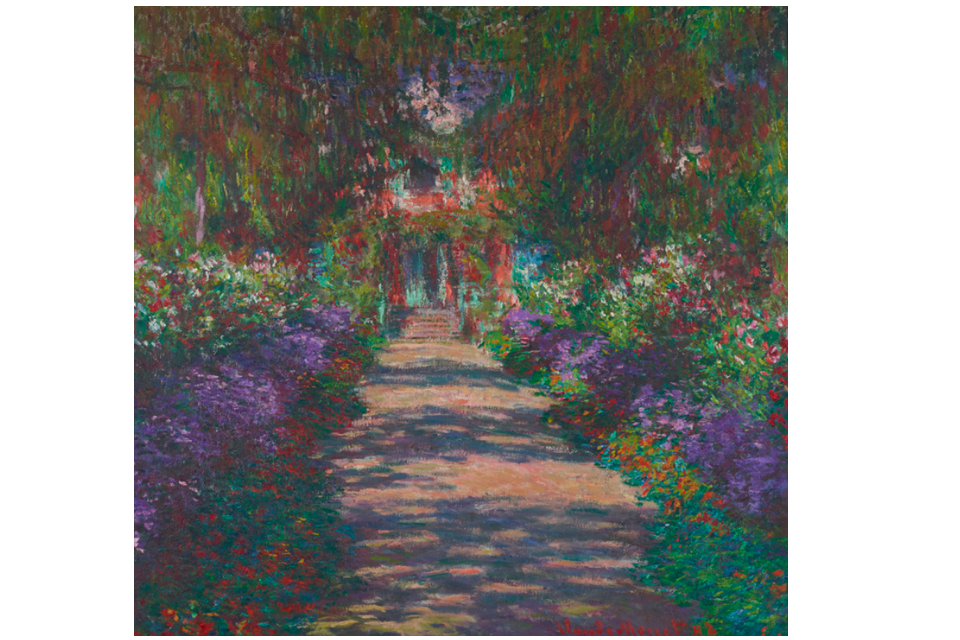
The Austrian Gallery Belvedere acquired the painting An Alley in Monet's Garden in Giverny by Claude Monet in 1942. © Austrian Gallery Belvedere
In 1941, the Secretary General of the Italian Chamber of Commerce in Vienna, Aldo Cima, as Giulietta von Mendelssohn’s authorized representative, entered into sales negotiations with Adolf Hitler’s “special representative” Hans Posse, among others, regarding the collection. The Kunsthistorisches Museum, the Österreichische Galerie and the Albertina subsequently acquired important artworks by French Impressionists as well as a self-portrait attributed to Rembrandt, partly through the mediation of the art dealer Otto Schatzker. With regard to these transactions, the Advisory Board determined, also with reference to the legal practice established within 100 meetings so far, that neither Giulietta von Mendelssohn nor her children Eleonora and Francesco belonged to the circle of persons persecuted by the Nazis. The sales were therefore not based on politically motivated prosecution or hardship. Hence, the Federal Minister was not recommended to transfer the property to the heirs of Giulietta von Mendelssohn in accordance with the Art Restitution Act.
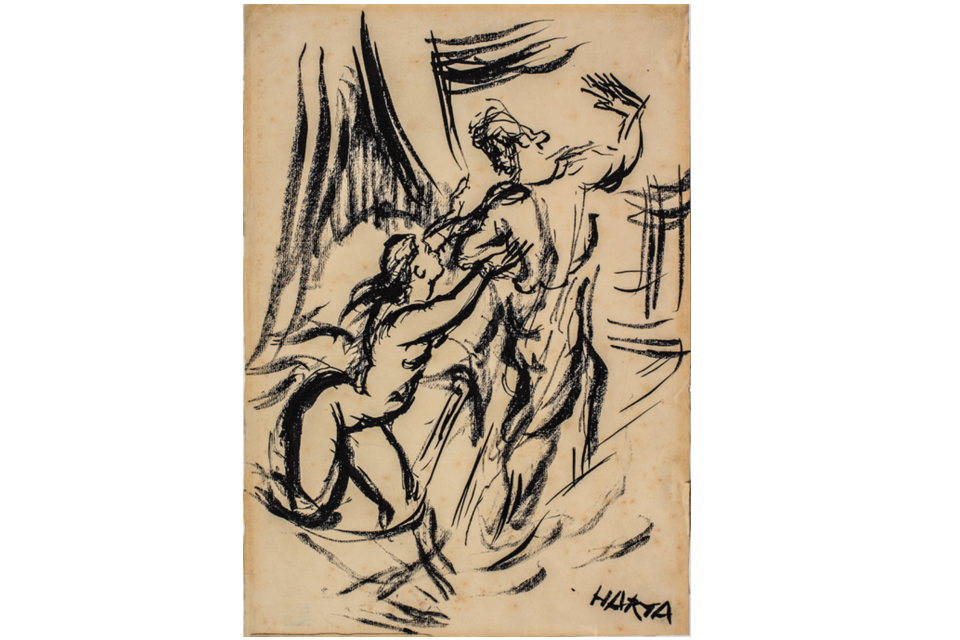
The drawing "Joseph and Potiphar" by Felix Albrecht Harta, created around 1920, was not recommended for restitution by the Art Restitution Advisory Board. © Academy of Fine Arts Vienna
With regard to a series of hand drawings by Robin Christian Andersen, Oscar Larsen, Felix Albrecht Harta and Anton Peschka from the Kupferstichkabinett (Graphic Collection) of the Academy of Fine Arts Vienna, as well as another drawing by Robin Christian Andersen from the Albertina, the Advisory Board also came to the conclusion that it should not recommend restitution to the heirs of Livia and Otto Brill. As the research of the Commission for Provenance Research revealed, all of the respective artworks bearing Otto Brill’s collector’s stamp were exported to Great Britain during his flight from Vienna in 1939 and entered the Viennese art market only after 1945. Furthermore, while it was proven that the Albertina acquired a sketchbook by Herbert Boeckl as early as 1934, it could be established that Stefan Pichler’s study of a horse was offered for sale to the Albertina along with other works by the artist himself. Pichler was initially sentenced to death for desertion in 1943, but the sentence was subsequently commuted to parole through frontline service. He fell at the front in 1944. After Albertina’s request to retrieve the sheets when the war ended remained unanswered, the Advisory Board suggested contacting his descendants and informing them of the sheets.
In its 102nd meeting on 29 June 2023, the Advisory Board dealt exclusively with objects from the Austrian National Library. The initial focus was on numerous printed materials and - from the Image Archive and Graphics Collection Department - negatives, positives and portrait prints, watercolours and hand drawings, all of which were assigned to the National Library by the Gestapo during the Nazi era. The Advisory Board therefore concluded that these allocations were Nazi persecution-related seizures. As the previous owners could not be identified even after years of provenance research, it was recommended that the objects be transferred to the National Fund of the Republic of Austria for Victims of National Socialism.
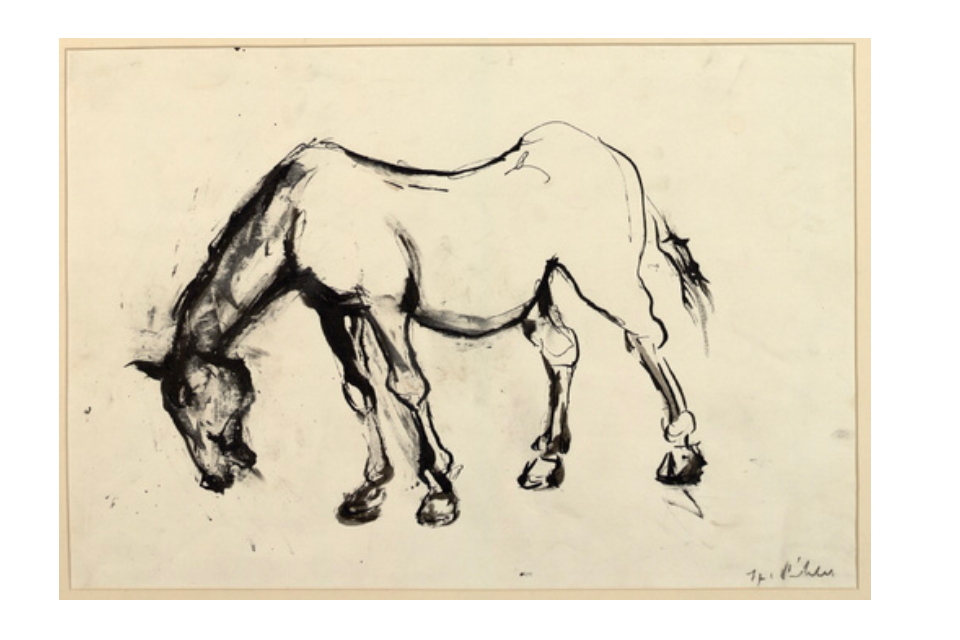
The artist Stefan Pichler submitted this study of a horse to the Albertina (Inv. Nr. 28034) for inspection and after he was killed at the front in 1944, never collected it. The Advisory Board therefore recommended that the artist's heirs be contacted regarding its collection. Photo: Albertina, Wien
On the other hand, a clear assignment was possible in the case of a Mahzor from the year 1415: As research has shown, the Jewish prayer book was purchased in 1842 by Salomon Mayer Rothschild, who then gave it to his son Anselm Salomon. According to the Hebrew dedication inscription, the parchment manuscript was to remain in the family “for future generations”. Finally, the Mahzor was inherited by the great- grandson of the former buyer, Alphonse Rothschild, who owned a famous and extensive art collection. The family was affected by the comprehensive confiscations of the Nazis after the “Anschluss” in 1938; Alphonse Rothschild died in US exile in 1942. The Advisory Board therefore saw no reason to assume that the Rothschild family had parted with the prayer book of its own free will, and recommended its return.
The text of the decisions can be found on the website of the Commission for Provenance Research at www.provenienzforschung.gv.at.
Pia Schölnberger Director of the Commission for Provenance Research and head of the office of the Austrian Art Restitution Advisory Board at the Federal Ministry of Art, Culture, the Civil Service and Sport.
New entries released in the Lexicon of Austrian Provenance Research
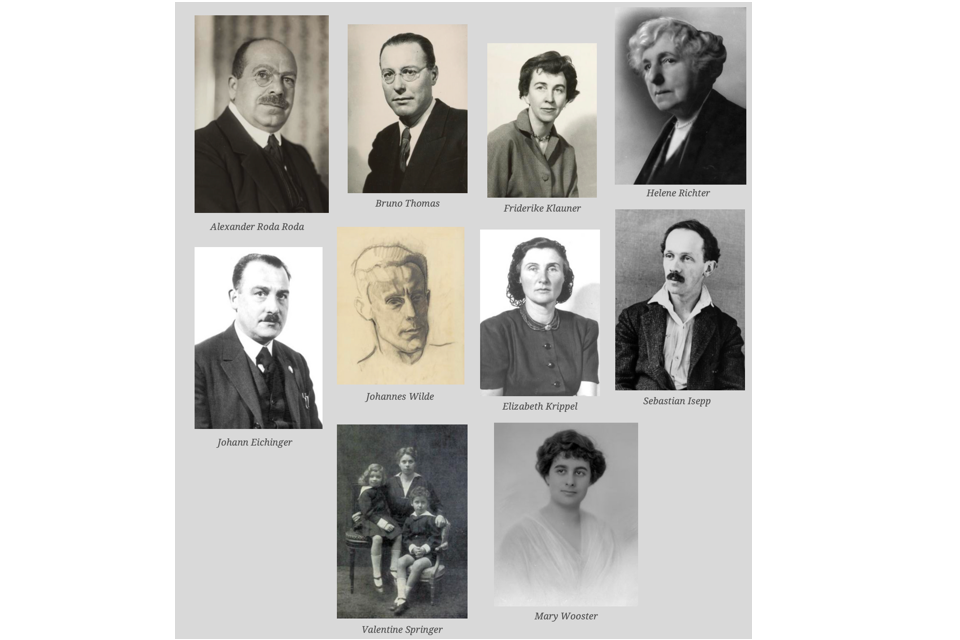
Pictures 1-10: Collage of new entries in the Lexicon of Austrian Provenance Research
Since 4 July 2023, 20 new articles, written by Gabriele Anderl, Julia Eßl, Nicole-Melanie Goll, Susanne Hehenberger, Stefan Kurz, Monika Löscher and Ulrike Nada, are online. The texts deal, among other things, with two art and cultural institutions and one of their key representatives during the Nazi era (the Landesleitung der Reichskammer der bildenden Künste beim Landeskulturverwalter, Gau Wien, the Freundeskreis der Akademie der bildenden Künste Wien and Leopold Blauensteiner). Seven articles are dedicated to persons persecuted by the Nazi regime and the whereabouts of the art objects seized from them (Rudolf Hirschenhauser, Helene Richter, Richard Neumann, Saul Juer, Alexander Roda Roda, Mary Wooster and Valentine Springer). Others outline the careers of five Austrian museum employees (Anton Kraus, Berta Eichinger, Johann Eichinger, Friderike Klauner and Bruno Thomas) and five conservators (Sebastian Isepp, Eduard Kneisel, Elisabeth Krippel, Ingeborg Spann and Johannes Wilde) before, during and after the Nazi era. The new releases thus highlight institutions, individuals and topics that have preoccupied provenance research in Austria for the past 25 years.
Konstanin Ferihumer has been working on behalf of the Commission for Provenance Research at the Academy of Fine Arts in Vienna since 2016. He is editor of the Lexicon of Austrian Provenance Research and since 2021 provenance researcher on behalf of the Commission for Provenance Research at Leopold Museum-Privatstiftung.
Susanne Hehenberger is a historian and archivist. She has been working as a provenance researcher at the Kunsthistorisches Museum Wien on behalf of the Commission for Provenance Research until 2016 and has been editor of the Lexicon of Austrian Provenance Research since 2018.
News: Germany
Memorandum from the members of the Advisory Commission
The ten members of the German Advisory Commission on the return of cultural property seized as a result of Nazi persecution, especially Jewish property have taken the 20th anniversary in September 2023 as an opportunity to set out the need for development and reform of its work, and recommends the introduction of a restitution law in a memorandum. This memorandum has received a very large echo in the national media and has become the subject of consideration and discussion by politicians and provenance researchers.
The German Advisory Commission was established 20 years ago in 2003. Currently it is made up of ten public figures under the former President of the German Federal Constitutional Court, Prof. Dr. Hans-Jürgen Papier, as chairperson, and it advises on particularly complex looted art cases over the restitution of cultural property seized as a result of Nazi persecution. It is the only institution of its kind in Germany. It was established by the federal government, the Länder and the national associations of local authorities.
The 23 recommendations issued by the Advisory Commission on Nazi-Looted Property during the last 20 years have been regarded as trend-setting for years now, both in Germany and abroad. They play an important role in the decision- making process in which museums and their sponsoring bodies engage, and they are of considerable significance to the art market. The small number of recommendations issued by the Commission is due to the fact that victims and their descendants can only request mediation through the Commission if the museum or other public institutions agrees to this.
Until today there is still a large number of items of Nazi-looted art that have not been restituted. Some 40,000 search entries and a further 35,000 found- object reports of seized items are listed in the so- called “Lost Art Database” alone, a German platform dedicated to the publication of such international search and found-object reports.
This means that the conditions under which the Advisory Commission operates continue to be unsatisfactory. Both in Germany and abroad, there is ongoing criticism that the Federal Republic is neither sufficiently able nor genuinely willing to redress Nazi injustice with regard to cultural property in an adequate and comprehensive manner, despite the fact that cultural institutions do restitute cultural property in many cases without the involvement of the Advisory Commission. Statistics however, are not available.
In view of this and on the occasion of its 20th anniversary, it is important to the Advisory Commission to identify potential structural weaknesses for itself and with a view to the future and to set out necessary or conceivable approaches to reform.
The option to lodge a unilateral request for mediation
The main obstacle to comprehensive handling of looted art cases by the Advisory Commission is that the descendants of the victims do not have any option to initiate proceedings unilaterally. For this reason, the Advisory Commission calls for victims and their descendants to be given the opportunity to initiate proceedings before the Commission without having to depend on the voluntary cooperation of the cultural institution in whose custody the cultural property is.
Binding effect of the decisions
The Advisory Commission can currently only make recommendations and not issue binding decisions. The implementation of these decisions is left to the parties concerned. For this reason, legislation is required to regulate the establishment, status and composition of the Commission and also the decision-making procedure it follows.
Cultural property in private hands, substantive legislation on restitution is indispensable
Common practice in Germany has meant that up to now, virtually without exception, proceedings have dealt with cultural property in public ownership, To the exclusion of looted art owned by private individuals and private institutions. The Advisory Commission calls for Nazi-looted art held by private institutions and private individuals to be able to be included in restitution proceedings as well. If the aim is to go beyond the notion of voluntary action here, comprehensive legislation on restitution is required: under current civil law, claims for restitution linked to seizure as a result of Nazi persecution are not or no longer justified or enforceable.
Statutory regulatory alternatives
In the case of comprehensive legislation on restitution, the constitutional issues must be assessed and, in particular, care must be taken to ensure protection of the fundamental right of freedom of ownership under Article 14 (1) of the Basic Law. Bona fide owners who would be legally obliged to hand over cultural property would be entitled to compensation or settlement. As far as the role of the Advisory Commission is concerned, it would be conceivable to establish a solution under administrative law in which the Commission is the superior federal authority that decides on restitution requests, or else a solution under civil law in which the Commission is a compulsory arbitration court that precedes judicial proceedings. It would be a welcome step to develop the Commission further in this way since it is an institution that has now accumulated a great deal of experience and expertise.
Provenance research
Federally funded research into the provenance of works of art in Germany is inadequately regulated. In the vast majority of cases, research funds go to museums. As things currently stand, the analysis of research outcomes is not overseen by any independent organisation or body, but is likewise carried out by museums. The Advisory Commission calls for provenance research funding (a total of around 50 million euros since 2008) to no longer go solely to museums but to an independent research institute.
The Federal Republic of Germany has acknowledged its international and national responsibility as the legal successor to the German Reich, in particular to engage in the reappraisal of Nazi injustice and to return items of cultural property that were lost as a result of persecution. Germany does not live up to this political and moral responsibility because the existing regulations are inadequate, especially in controversial cases. For this reason, the Advisory Commission calls for its status and activity to be legally regulated.
News: United Kingdom
Report of the Spoliation Advisory Panel on La Ronde Enfantine by Goustave Courbet
On 28 March 2023, the Spoliation Advisory Panel considered a restitution claim on behalf of heirs of the late Robert Bing for an oil painting, La Ronde Enfantine, by Gustave Courbet now in possession of the Fitzwilliam Museum, Cambridge. The claimants submitted that the painting was seized from Robert Bing’s flat in Paris on 5 May 1941 by the Nazis.
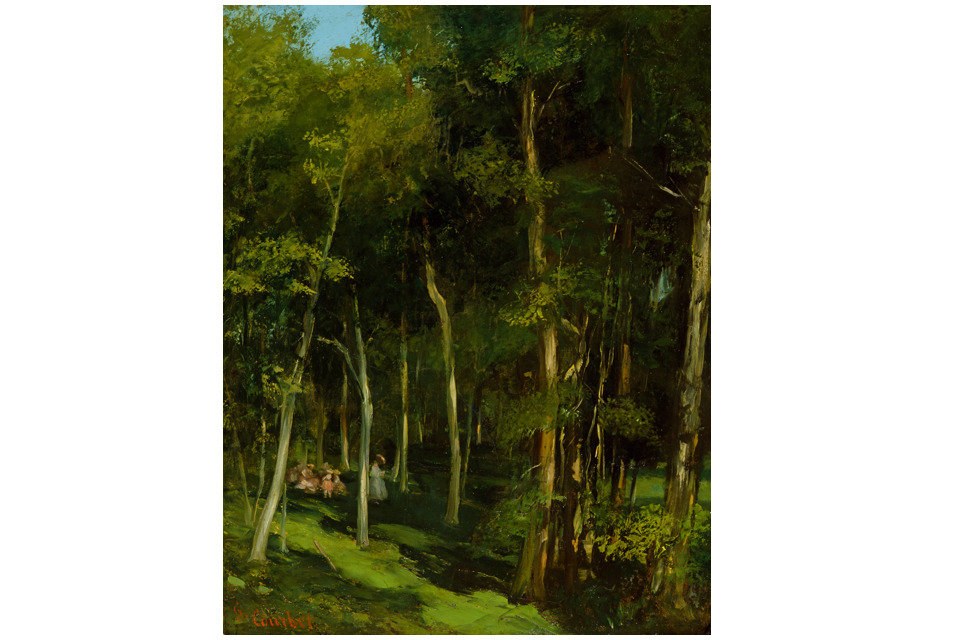
La Ronde Enfantine, by Gustave Courbet recommended that the Painting be restituted to © The Fitzwilliam Museum
The location of the painting was unknown in the immediate aftermath of the Second World War. It resurfaced in the inventory of the London art dealer, Arthur Tooth & Sons, in 1951. In the same year, Arthur Tooth & Sons sold the painting to the then Dean of York, The Reverend Eric Milner-White (1884-1963). He in turn donated it in the same year to the Fitzwilliam Museum in memory of his father. The work has remained in the collection of the Museum since then.
The Panel concluded that the evidence provided supported the claimants version of events and that the painting was seized by the Nazi occupying forces on account of Robert Bing being Jewish. The Panel recommended that the Painting be restituted to Mondex Corporation representing and on behalf of the heirs of Robert Bing.
Download the Panel’s full report
NMDC Nazi-era Provenance Research Training at The Victoria & Albert Museum
Report on the Spoliation Working Group’s Provenance Research Training at the Victoria & Albert Museum (V&A) April 2023 with National Museum Directors’ Council (NMDC).
When we look at the works of art on display in Britain’s museums, there is always a possibility that some of these objects once belonged to victims of the Nazi regime. This troubling legacy has often remained unexplored and unacknowledged for far too long. This is surprising in itself: these very same museums were acutely aware of Nazi looting across Europe, and many of them played an important role in the post-war restitution effort; some even counted former ‘Monuments Men’ among their curators after the war. Yet, from 1945 onwards, these institutions usually did not ask in-depth questions about the provenance of the items that they were adding to their collections.
This practice only changed in 1998, more than 50 years after the end of the war, with the landmark Washington Conference on Holocaust-Era Assets, which brought unprecedented awareness to the material legacies of the Nazi past in museum collections. Crucially, it emphasised that this was not just an issue for museums in Germany and the countries formerly occupied by the Nazis, but also potentially affected any museum in the world. In this context, the V&A’s former director, Alan Borg, who was also at the time the Chairman of the NMDC, placed this issue high on the agenda of Britain’s museums. NMDC issued a ‘Statement of Principles and Proposed Actions’, which condemned the Nazis’ radical campaign of persecution and dispossession and also committed museums to researching the Nazi-era provenance of their existing collections. Furthermore, it required museums to ask the same questions of potential acquisitions and incoming loans.
The task was vast and continues to this day, bringing its own unique challenges that often take art museum professionals beyond their disciplinary comfort zones. To support these professionals to carry out this important, difficult and time-consuming work, Dr Jacques Schuhmacher (Senior Provenance Research Curator supported by The Polonsky Foundation, V&A) and Dr Susanna Avery-Quash (Jacob Rothschild Interim Head of Curatorial, National Gallery) of the NMDC Spoliation Working Group organised a full-day Nazi-era provenance workshop on 27 April 2023 at the V&A. The first of its kind, this workshop brought together 30 curators, librarians, registrars and collections managers working on a wide range of collections across the spectrum of UK museums, representing institutions from Portsmouth to Hartlepool, London to Glasgow. The composition of the group made clear that the issues at hand touch every kind of collection, from national to regional and university holdings.
Historical foundations: The Nazi persecution and murder of European Jews, 1933-1945

Dr Thomas Brodie, Director of the Institute for German & European Studies presenting ‘The Nazi Persecution and Murder of European Jews, 1933-1945’
The first part of the workshop provided the vital historical background and policy context, an understanding of which is essential to contextualise this important work. Dr Thomas Brodie, Director of the Institute for German and European Studies and Lecturer for 20th-Century European History at the University of Birmingham, gave a lucid and often moving overview concerning ‘The Nazi Persecution and Murder of European Jews, 1933-1945’. As Dr Brodie made clear, at the core of the Nazi movement’s worldview was its hatred of the Jews. Once installed in the corridors of power, they mobilised the might of the German state to torment the Jewish community. The regime issued a series of escalating decrees, accompanied by waves of violence, designed to exclude Jews from public life and the economy, forcing them into a state of isolation and despair. As the social, economic and legal pressures continued to build, many Jews were left with no choice but to part with their possessions, hoping either to raise funds in order to survive in this hostile environment, or to finance their escape from Hitler’s regime. As the Reich aggressively expanded across the European continent, the Nazis exported their ideology and its mechanisms of persecution and dispossession, all of which were further radicalised in the violent environment of war. This would ultimately lead to the systematic mass murder of millions of innocent Jewish men, women and children. Dr Brodie shed light for us on this vast and complex campaign, whose terrible mission is encapsulated in the words of a Holocaust survivor: ‘Slaughter the Jews and take their property’. Among the myriad items confiscated were countless works of art.
Post-war realities: From the Monuments Men to the 1998 Washington Conference and beyond
Following this insightful historical overview, Dr Jacques Schuhmacher (V&A) turned the spotlight onto Britain’s museums. Even before the Nazi regime was defeated, curators and art historians in the service of the Allies gathered huge amounts of information concerning Nazi looting. Their goal was to recover and return the vast number of looted works of art to the galleries and private collections from which they had been taken. In the ruins of the Third Reich, curators and others cataloged objects and painstakingly attempted to establish where each one had come from, resulting in the restitution of millions of items.
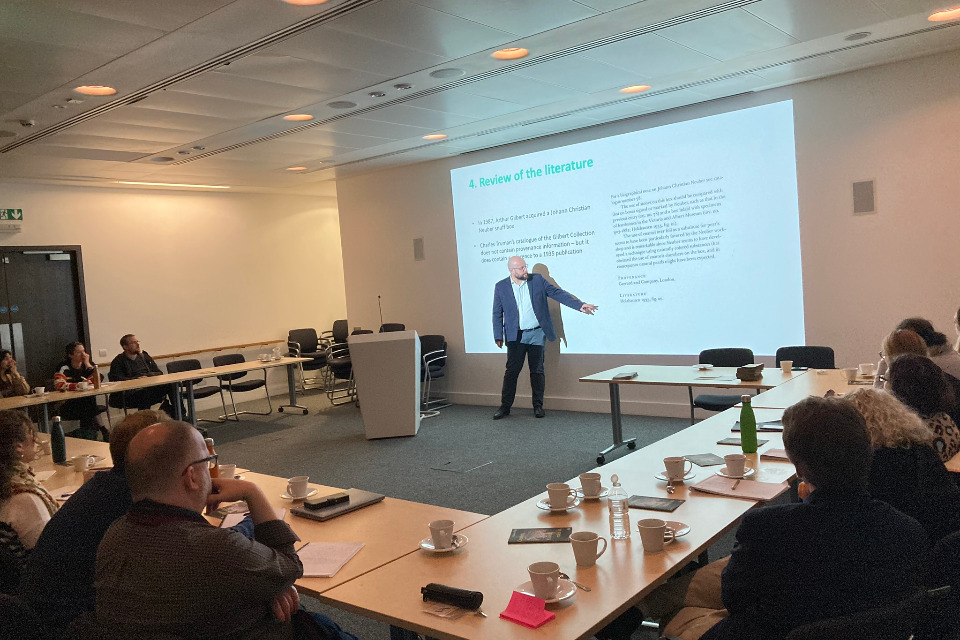
Dr Jacques Schuhmacher (V&A) presenting on British Museums and the creation of the Spoliation Working Group
While this was a truly remarkable effort, museum collections were not subjected to the same scrutiny as the treasures recovered from Nazi institutions. This unexamined legacy continued to grow until the 1998 Washington Conference unexpectedly catapulted the issue back to the forefront of the art world. The Washington Principles on Nazi-confiscated Art galvanised research into Nazi-era provenance across the museum world. Dr Schuhmacher highlighted the favorable environment for this important research in the UK. In contrast to many other countries, the British museum sector recognised the moral urgency of the task and made an unequivocal commitment to this work, resulting in the NMDC Statement and the creation of the Spoliation Working Group, which coordinates the efforts of UK museums in this area. Furthermore, NMDC created the Advisory Group on Spoliation Matters, a group of experts who provide specialist advice to museums.
The work of these bodies is further assisted by the fact that the UK is among a small number of countries to set up an independent restitution committee in the form of the UK Spoliation Advisory Panel, which makes the recommendations about the fate of objects carrying a problematic provenance.
Tackling the Nazi-era provenance of museum collections: Research strategies and resources
In the second part of the workshop, Dr Schuhmacher and Dr Avery-Quash shared strategies for undertaking this crucial research. Researching the Nazi-era provenance of a museum collection can initially feel daunting and intimidating, not least because of the number of objects involved, their diversity and complex histories. It may also be disorientating to realise that there is not always an obvious place to start. Schuhmacher highlighted that, for example, Jewish collectors naturally appreciated every type of art, ranging from Christian icons to East Asian vessels, modernist paintings to archaeological pieces and classical masterworks. This means that we should never exclude objects from investigation on the grounds of who made them or their place of origin. To do so would be to underestimate the agency and interests of Jewish collectors, and the dynamic flows of the networks of collecting and the reach of the international art market in the first half of the twentieth century. Another common misconception is the fact that the fall of the Third Reich marks a clear cut-off point for our investigations. Instead, we should remember that many relevant objects entered museum collections decades after the war, right up to the present day. Schuhmacher highlighted the limitation of British museum records, which often contain only the name of the owner who gave the object to the museum, in which case they provide merely the starting point for this research. The main challenge is that there is no consolidated list of all the works of art which the Nazis confiscated or extorted from their victims, against which a list of museum objects could be compared. Dr. Schuhmacher explained how to use online databases which now allow provenance researchers potentially to sidestep years of fruitless searching in archival holdings, and to connect the objects to a past that is not immediately obvious from the museums’ own records. Using case studies from museums in Britain and Europe, Dr. Schuhmacher outlined the research strategies that can be deployed to fill thegaps in an object’s provenance and to discover its full history. During the discussion of how the participants might approach researching their own collections, Dr. Avery-Quash emphasised that it is always important to be mindful of the work done by provenance researchers on the continent, which is discoverable through Proveana and the Central Registry for Information on Looted Cultural Property 1933-45, which is arguably the best starting point and research resource for English-speaking provenance researchers.

Alice Minter, Senior Curator at the V&A, providing a tour of the Gilbert Galleries at the V&A, London.
Bringing provenance research into the galleries
The day concluded with a discussion on how museums are beginning to share this research with a broader public who are increasingly interested in learning the unvarnished, full and complicated provenance histories of the items on display. Alice Minter, Senior Curator at the V&A, gave a tour of the Gilbert Galleries at the museum and shared the curatorial considerations behind its pioneering special provenance display, ‘Concealed Histories: Uncovering the Story of Nazi Looting’. Attendees were able to examine key items in the display and the provenance stories behind them that the team at the V&A had uncovered using the research techniques described throughout the workshop. Minter emphasised the importance of embedding these objects and their Nazi-era narratives into existing public displays in order to contextualise them properly, and to ensure that vital and intriguing provenance research could reach traditional and new audiences alike. It is pleasing to note that the workshop was met with much interest and that many participants told us they had gained a better understanding of the issues at stake as well as of the tools necessary to embark purposefully on this vital research. We hope to build on this initiative through offering further training events in different parts of the UK.
Further information and reading
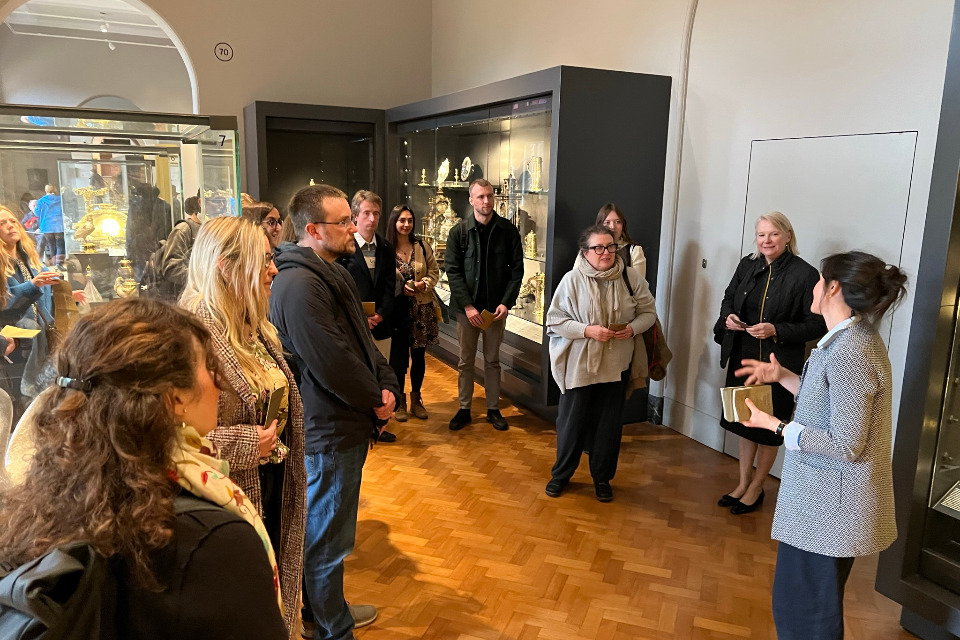
Alice Minter, Senior Curator at the V&A, discussing the curatorial considerations behind the pioneering special provenance display, ‘Concealed Histories: Uncovering the Story of Nazi Looting’ at the V&A, London.
-
NMDC Statement: Spoliation of works of art during the Holocaust and World War II period: [Statement of principles and proposed actions
-
Collections Trust: Spoliation research by UK museums for 1933-45 - [database of spoliation reports from UK museums.
-
Concealed Histories: Researching Nazi Looting in the Gilbert Collection, in: Alice Minter (ed.), Miniatures in Motion. [Highlights from the Rosalinde and Arthur Gilbert Collection, V&A, 2021.
-
British Museums and Holocaust-Era Provenance Research, in: Ruth-Redmond Cooper (ed.), Museums and the Holocaust. Second Edition, [Institute of Art and Law, 2021.
-
Nazi-Era Provenance of Museum Collections. A Research Guide, London: University College London Press, forthcoming.
News: France
A new bilateral meeting bringing together the French deliberative college and the Austrian Advisory Board
Following on from the first bilateral meeting last year in July 2022 in Berlin (cf. Newsletter 14) between the members of the German Beratende Kommission and the deliberative college of the CIVS, a two-day seminar was held in Paris in June 2023 between the Austrian Kunstrückgabebeirat Advisory Board linked to the Kommission für Provenienzforschung and the deliberative college of the CIVS, with the participation this year of the M2RS (Ministry of Culture’s Mission for Research and Restitution).
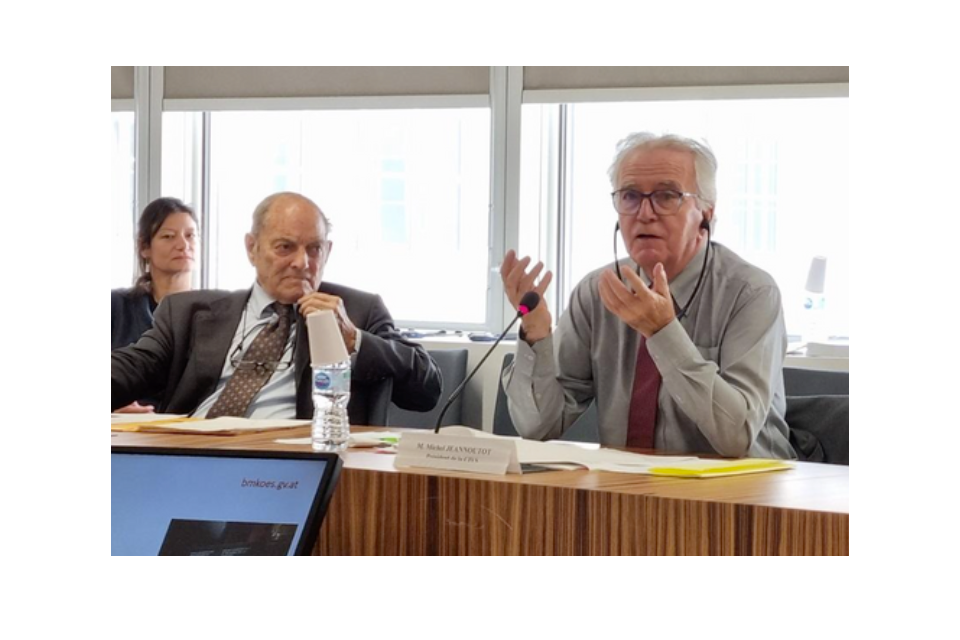
President of the CIVS, Mr Jeannoutot, speaking at the seminar. ©CIVS
The President of the CIVS, Mr Jeannoutout, opened this Franco-Austrian meeting by mentioning the foundations of the European rapprochement between the various restitution committees, the setting up of an action plan in London in 2018 and the creation of the Network of European Restitution Committees on Nazi- Looted Art in 2019, as well as the numerous cooperation and projects between the France and Austria in recent years.
Learning from each other: a shared objective
Half a day was devoted to presenting the two commissions, their members and their compensation policies. Mr. Univ. Prof. Dr. Jabloner, Chairman of the Board, began by expressing the hope that this meeting would be rich in exchanges, given that the two commissions have the same objective, and that it is important to take advantage of this seminar to learn from each other and enrich the working methods of each of the commissions.
Comparing methods through practical contrasts, between similarities and differences
The following day, a practical case study session was organised with an open simulation of the work of the French deliberative college on an Austrian recommendation. At the initiative of Ms Bitter, General Rapporteur of the CIVS, the simulation of the case of the spoliation of the “Julius FREUND Collection” enabled the two commissions to see for themselves the particularities of each of the structures in the application of the law or decree leading to a recommendation. This unusual case study gave the two commissions a better understanding of each other’s know-how and skills.
A genuine, sincere and trusting exchange has taken place
The general consensus was that the meeting was a great success, with a significant learning effect on both sides. Based on trust and sincerity, the discussions on common problems or difficulties encountered were marked by their conviviality, precision, and frankness. Although these exchanges of views will not fundamentally change the practices of either commission, they certainly will serve to fuel and encourage reflection in the drafting of recommendations.
At a reception at the Austrian Embassy in Paris, Mr Wolfgang Wagner, Chargé d'Affaires a.i. of the Austrian Embassy in France, congratulated the two commissions on their efforts to communicate and help each other, and on their shared commitment to helping the victims of the crimes of National Socialism.
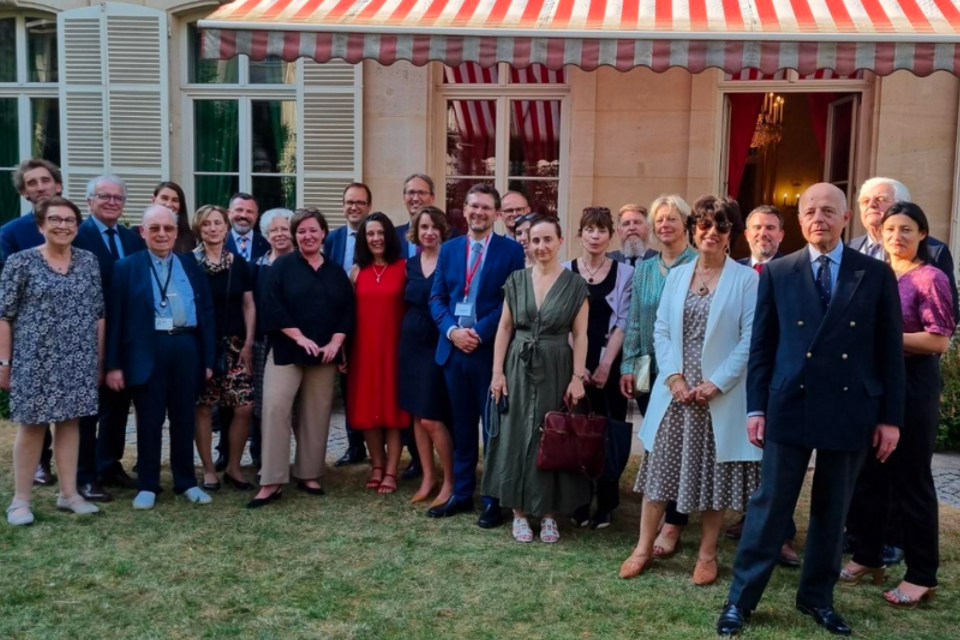
All those in attendance at the reception at the Austrian Embassy in Paris. ©CIVS
Article: France
A bill concerning the restitution of cultural property spoliated as a result of anti-Semitic persecution between 1933 and 1945 has been passed.
The purpose of this bill is to facilitate and accelerate the restitution of cultural property belonging to public collections looted, in France or elsewhere, from Jewish citizens during the National Socialist period, between the time when Adolf Hitler came to power on 30 January 1933 and the German surrender on 8 May 1945. A new regime for the release of cultural property from public collections has been introduced.
The bill was presented to the Council of Ministers on 19 April 2023 by Rima Abdul Malak, Minister of Culture. The government then initiated an accelerated procedure. The bill was adopted on first reading, with amendments and unanimously, by the Senate on 23 May 2023. Then on 29 June 2023, the National Assembly unanimously adopted the bill on first reading, also with amendments.
On 6 July 2023, the Joint Committee (composed equally of seven deputies and seven senators, in order to combine the points of view of the National Assembly and the Senate on a bill under consideration) reached agreement on a final version of the bill. On 13. July, this compromise text was finally adopted by both. The law was officially published in the Official Journal of the French Republic (French: Journal officiel de la République française) on 22 July 2023. This law and the resulting decrees should come into force on 1 January 2024.

Rima Abdul Malak, the French Minister of Culture. ©Thibaut Chapotot
Behind each work is a family history. Behind every plunder is a human tragedy. Every restitution is an act of justice
Rima Abdul Malak, 29 June 2023
This is the first law since the Libération to recognise the specific spoliation suffered by Jews, in France and everywhere, under the National Socialist regime, and the various authorities linked to it, especially, in France, the “Etat français” (“French State”), the Government of Vichy.
Why such a law? A real need to simplify restitution procedures in France
This law reflects the will of the Government to pursue the public policy of justice and memory, prompted in 1995 by President Jacques Chirac when he acknowledged France’s responsibility for the crimes of the French State and implemented by the study mission on the plunder of the Jews of France, known as the Mattéoli mission (1997-2000), then by the Commission pour l’indemnisation des victimes de spoliations (CIVS) created in 1999.
Thousands or even millions of goods (artworks, books, musical instruments, etc.) were looted in a variety of ways (theft, looting, confiscation, and seizure in the form of Aryanisation, under duress or forced sales). More than 45 000 assets were returned in the immediate post-war period.
Restitutions have accelerated since the 1990s. But during the last 25 years, the restitutions of cultural goods have almost exclusively concerned so-called “Musées nationaux récupération” (MNR) artworks, which do not belong to the national collections and can be returned by the administration to their owners.
But tens of thousands of other looted items have not been identified and are still being sold on the art market or have found their way into public museums collections and libraries. Property held in public collections can only be returned if a law is passed to override the principle of inalienability set out in the French Heritage Code. To date, such restitutions have been rare, mainly because of the complex process involved in removing artworks from the public domain.
The law of 21 February 2022, presented by Roselyne Bachelot, Minister of Culture at the time, (on the restitution or surrender of certain cultural property to the rights holders of their owners victims of anti-Semitic persecution), also adopted unanimously, fourteen works from the national collections and one from the city of Sannois were released from the public domain, including a painting by Gustav Klimt entitled “ Rosiers sous les arbres “ (Rosebushes under the Trees), held by the Musée d'Orsay in Paris.
However, in order to avoid delaying new returns, a framework law was expected to facilitate the removal from the public domain of goods whose dispossession is established without recourse to specific laws and without asking Parliament repeatedly. The law thus creates, in the heritage code, a derogation framed by the principle of inalienability of public collections: the decision of restitution will henceforth be taken by the Prime Minister or by a deliberation of the local authorities, after consulting the CIVS, which is responsible for establishing the facts of the spoliation. Thus, when after investigation the plunder will be recognised, the restitution of the work will be legally permitted.
The bill also stipulates other methods of compensation
The bill also provides that various forms of reparation may be considered, by mutual agreement between the public authority and the looted owner or his heirs. For example, a financial transaction could be concluded instead of restitution. The item would then remain in the public collection.
The law will apply to claims for restitution under consideration on the date of its publication.
Following an amendment by Members of Parliament, the government will be required to submit a report every two years listing the restitution of looted art. This report will keep Parliament informed of all restitutions of looted property in a single document.
What this means for the CIVS: the reform will strengthen its missions
This bill aims to simplify the procedure for the restitution of looted property belonging to public collections. The new procedure provides for the CIVS to give its opinion before a restitution decision is taken. In the case of cultural property, the scope of the CIVS’s work should now be extended to anti-Semitic spoliations committed between 1933 and 1945 (previously only during the German Occupation of France from June 1940 to the end of 1944), in all territories controlled or influenced by Nazi Germany.
This bill provides for a decree in the Conseil d’État to specify the rules relating to the competence, composition, organisation, and operation of the CIVS. Work is underway to draft this new decree, which will replace the regulations that have governed the work of the CIVS since 1999.
For example, the decision to remove artworks from collections may only be taken after the opinion of the CIVS, which is responsible for establishing the facts, determining the circumstances of the spoliation and recommending restitution.
The restitution of spoliated artworks forming part of the private collections of museums that have been awarded the “Musée de France” designation will also be possible after receiving the opinion of the CIVS commission and the approval of the administration.
To ensure that this reform is implemented in the best possible conditions, a decree extending the mandates of the ten members of the CIVS was published in the Journal Officiel on 8 July 2023. Initially appointed for three years in September 2020, they are now extended until 31 December 2023.
These new developments in the mission of reparation entrusted to the CIVS reflect unanimous recognition of the work carried out since 1999.
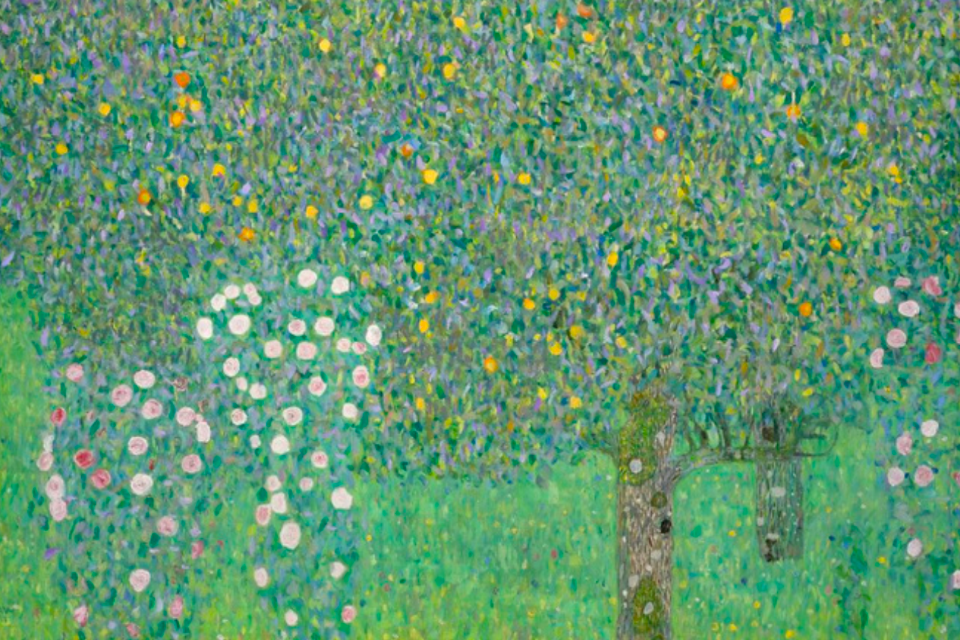
Gustav Klimt, Rosiers sous les arbres, vers 1905, Musée d'Orsay © Musée d’Orsay, Dist. RMN-Grand Palais / Patrice Schmidt The restitution of Gustav Klimt's painting Rosiers sous les Arbres [Rose Bushes Under the Trees], held at the Musée d'Orsay can commence once the bill that authorises the removal of the work from the national collections, on the basis of the looting that occurred in 1938, is enacted in January 2024.
Case study: Austria
Restitution of Anton Romako’s watercolour study “Reclining hunting dog”
Armin Reichmann’s granddaughter reunited with the artwork from her grandfather’s art collection after more than 80 years.
Two almost identical watercolour studies, two different provenance histories, one successful art restitution. In 2005, Armin Reichmann’s granddaughter set out to find her grandfather’s long-lost artwork. The difficulty of this search was that the Austrian artist Anton Romako (1832– 1889), painted two delicate studies titled “Reclining hunting dog” to serve as studies for one of his oil paintings, whose current whereabouts are unknown. Both watercolour studies show the almost identical motif of a sitting hunting dog, apart from the positioning of the dog’s tail, and the position of Romako’s signature. The two watercolours also differ in dimensions. While one of those studies belonged to the art collection of the journalist Armin Reichmann and was later purchased from an Austrian art dealer by the Albertina Museum in 1941, the other one belonged to the painter Carl Moll since possibly 1911 and is now privately owned. Hence, the question to be answered by provenance research was, which study had previously belonged to Armin Reichmann?
Born in Vienna on 7 December 1878, Reichmann studied law at the University of Vienna and worked as a journalist. He had great interest in culture, music and arts and owned a collection of fine art objects. Considered as a Jew under the Nuremberg Laws after the “Anschluss” of Austria to the National Socialist German Reich, Armin Reichmann was forced to submit a declaration of assets in July 1938. This list shows that his collection included precious metals and jewellery, silverware, Persian carpets, a library, as well as paintings and drawings. In addition, it contains the entry “Romako (watercolour): Dog (signed)”, undoubtedly one of the two studies for the oil painting. His collection can be traced until 1938, when he lived with his wife Rosa and two children in the 9th district of Vienna. Rosa, née Mühlendorf, born on 23 May 1888, was his first wife, whom he married a second time after a divorce, following the unexpected early death of his second wife. While their two children, Erika and Kurt, managed to flee the country, the couple was forcibly relocated to a “Sammelwohnung” (collective apartment) that they had to share with five other people. On 2 June 1942, they were deported to Minsk by train and presumably four days later were murdered at the Maly Trostinec extermination site in the forests of Blagowshtchina in Belarus.
At the time of the murder of their parents, Erika and Kurt had already succeeded in leaving Vienna. In March 1939, Erika emigrated to England, even though her application for financial support for her “travel expenses” to escape from Vienna had been rejected by the Jewish Community of Vienna. Erika, who like her father studied law at the University of Vienna, was a doctoral student at that time. She had hoped to receive her doctorate at the end of June 1938, but in March of that year, all her efforts were thwarted. In order to save his daughter’s life, Armin Reichmann apparently paid RM 1,000 for her escape in March 1939. She finally left for England and had to earn her living as a hotel chambermaid. Her younger brother Kurt had gone to Latvia for a year’s advanced training on an agricultural farm, from where he intended to return to Vienna in April 1938 to continue his law studies. But that was no longer possible due to the events that had occurred in the meantime. In April 1942, after four years as a refugee in Latvia, Denmark, England and Australia, he finally emigrated to Palestine where he chose to live on a Kibbutz. The parents also desperately tried to leave Vienna. In April 1940, Armin Reichmann cabled to their affidavit-guarantor Rose Singer in Miami Beach in a last attempt: “Request telegraphic payment of two ship tickets with Italia or Unitedstatesline, otherwise departure impossible.” The departure remained impossible.
The whereabouts of Armin Reichmann’s art collection between its last mention in his declaration of assets in 1938 and his murder in 1942 remain unclear. Since no seizure can be proven, it is to be assumed that the artworks were sold by Armin Reichmann in a last attempt to raise money for his wife’s and his deeply hoped-for emigration.
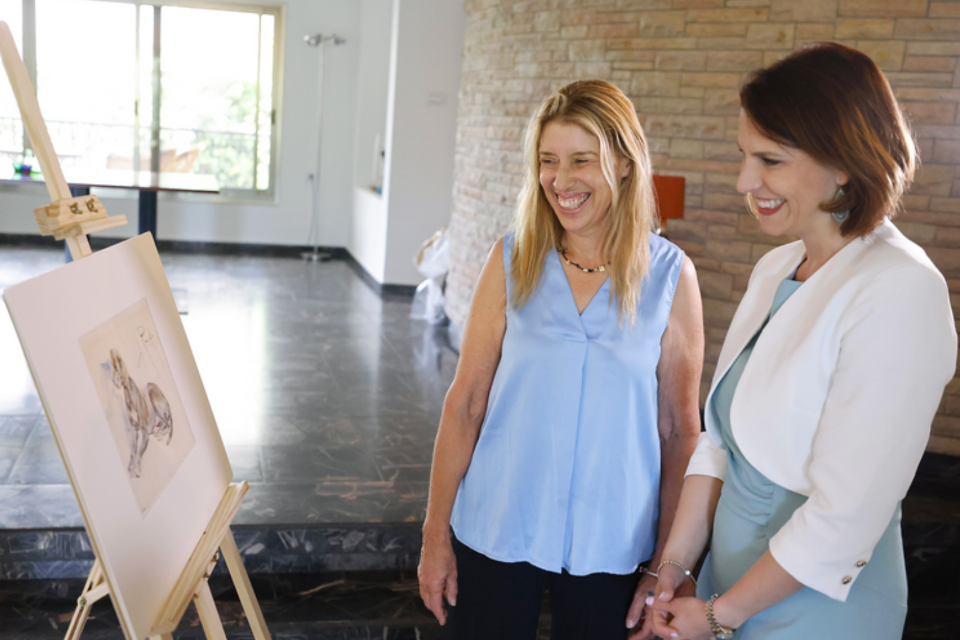
Armin Reichmann's granddaughter, Neta Rimon-Pleavsky,(left) and the Austrian Federal Minister for the EU and Constitution, Karoline Edtstadler (right), in front of the watercolour study by Anton Romako at the restitution ceremony at the Austrian Embassy in Tel Aviv.
Extensive provenance research conducted on behalf of the Commission for Provenance Research in the holdings of the Albertina has revealed that the study, which has been in the museum since 1941, is the one that once belonged to Armin Reichmann. The study was first mentioned in the catalogue raisonné of Anton Romako published by Fritz Novotny in 1954. Accordingly, it may have been shown in November/December 1905 at the sales exhibition of the Viennese art gallery Galerie Miethke. The Albertina purchased the artwork from the gallery Galerie Welz in Salzburg in 1941, which a handwritten entry in the museum’s inventory book revealed. The gallery was owned by Friedrich Welz, who then also took over the “aryanised” Viennese gallery Galerie Würthle in April 1938. His involvement in Nazi confiscations of property and the fact that he profited from a large number of similar cases is very well documented today. Armin Reichmann no longer owned his watercolour study in April 1941, as can be seen from the appraisal record of Alois Getzinger, a court-certified expert and master appraiser at that time. The fact that the Albertina Museum purchased the artwork in 1941 from Friedrich Welz suggests that this is the watercolour study once owned by Armin Reichmann. However, no written record which shows that Armin Reichmann sold his study directly to Friedrich Welz could be found in Friedrich Welz’s business records. It can be strongly assumed that Armin Reichmann sold the work to Friedrich Welz “privately” in his desperation and fight for survival. The assumption of this being a “private” sale is also supported by the fact that since December 1938, Jewish people were not allowed to freely sell their own artworks. Another possible reason why the sale was not recorded is that Reichmann did not sell his study directly to Friedrich Welz, but through a third party.
The history of the other watercolour study also supports the conclusion that the study from the Albertina Museum is the one that once belonged to Armin Reichmann. The current owner acquired it from the estate of Carl Moll’s grandson in the early 1960s. Intermediate ownership of the other study by Armin Reichmann seems unlikely, if Carl Moll acquired the watercolour study from the auction house C. J. Wawra in 1911, where it is first mentioned in writing, and then passed it on to his grandson, who owned the study until his death in 1960.
At its 60th meeting on 2 March 2012, the Austrian Art Restitution Advisory Board, having considered the facts presented and in agreement with them, recommended the restitution of the artwork formerly owned by Armin Reichmann to his legal successors. On 12 June 2023, after the clarification of open inheritance law issues, especially by Sabine Loitfellner, the granddaughter of Armin Reichmann, Neta Rimon- Pleavsky, received the artwork from the hands of the Austrian Federal Minister for the EU and Constitution, Karoline Edtstadler in a touching ceremony at the Austrian Embassy in Tel Aviv. The heiress was visibly moved as she pointed out that she never had the chance to meet her grandparents. The work of the Commission for Provenance Research therefore made it possible that besides the artwork, a part of her grandparents and her family’s history was given back to her.
The research on the causa Armin Reichmann was conducted by Pia Schölnberger, former provenance researcher at the Albertina and now head of the Commission for Provenance Research. The text was created with the support of Nicoletta Müller, who completed a specialized internship at the Bureau of the Commission for Provenance Research and is studying art history at the University of Vienna.
To see the outcomes and decisions of the 60th meeting on 2 March 2012, of the Austrian Art Restitution Advisory Board, visit the Commission for Provenance Research and Art Restitution Advisory Board
Case study: Austria
From Freudenthal to Vienna: On the restitution of a fortepiano to the Teutonic Order
At its meeting on 14 June 2019, the Art Restitution Advisory Board recommended the restitution of a fortepiano to the Teutonic Order. The Teutonic Order in Bruntál (Freudenthal) originally owned the instrument, which was made by Viennese piano maker Michael Rosenberger in 1810. Freudenthal, a small town in northern Moravia, is one of the oldest Bohemian royal towns. After the First World War, the town became part of the newly founded Czechoslovakia and was assigned to the German Reich together with the Sudetenland by the Munich Agreement in 1938. After 1945 it was once again part of Czechoslovakia. The majority of the German population was expelled.
The Freudenthal dominion had been owned by the Teutonic Order since the Thirty Years’ War. Along with the Knights of St. John and the Knights Templar, the Teutonic Order was the third of the great ecclesiastical orders of knighthood during the period of the medieval crusades. On 1 September 1938, property of the Teutonic Order was banned in Austria, and on 27th February 1939, in Czechoslovakia, which had then been annexed by Hitler. The Teutonic Order in Freudenthal was then expropriated, and Robert Schälzky, the GrandMaster at that time, was forced to leave the Grand Master’s residence. He was interned in a forester’s lodge before finally living in the former Order house in Troppau under Gestapo supervision.
Parts of the art collection, such as graphics, coins and medals, were given to the Gaumuseum Troppau, today’s Silesian Regional Museum. Freudenthal Palace became the property of the Reichsgau Sudetenland; the majority of the rooms were initially used as offices by the Reich Forestry Office and the NSDAP. After the art collections (Order Treasure, paintings, graphics and the coin collection) of the Austrian Teutonic Order were transferred to the Kunsthistorisches Museum Vienna in autumn 1938, Fritz Dworschak, the provisional director, also showed interest in the holdings from Freudenthal.
In the spring of 1940, the “Aufbaufonds” Vermögensverwaltungs-Gesellschaft m.b.H. (“Development” Asset Management Company Ltd.) offered to come to Silesia to make a selection of the art objects that were to be taken over. This was the successor organisation to the Liquidation Commissar for Societies, Organizations and Associations (Stiko), the office installed in Austria in March 1938, whose initial task was to enforce political conformity (“Gleichschaltung”) in the Austrian association system, and later also in the Reichsgau Sudetenland and the Protectorate of Bohemia and Moravia. The so-called Stiko is considered the central instrument of the Nazi state for carrying out the systematic confiscation of association assets.

Transfer and sound test of the Rosenberger fortepiano, 6.2.2023 © Daniel Willinger f.l.t.r. Eugène Michelangeli, Monika Löscher, Ulrike Sych, Frank Bayard OT, Pia Schölnberger
Together with Leopold Ruprecht, the head of the Kunsthistorisches Museum’s weapons collection, Fritz Dworschak set off on his journey to Silesia in order to select the works of art for the Aufbaufonds which he would then request upon his return on 4 June 1940. Since Dworschak was in favour of founding an Order Museum in Silesia, he claimed only the fortepiano made by Michael Rosenberger for the Kunsthistorische Museum. It was finally transferred to Vienna in March 1942.
In January 1948, the Kunsthistorische Museum Vienna transferred the fortepiano as a loan to what was then called the Academy of Music and Performing Arts. In 1987, the instrument finally passed into the inventory of the Institute for Viennese Sound Style of what at that time was called the Academy of Music, now the University of Music and Performing Arts Vienna.
At its meeting on 14 June 2019, the Art Restitution Advisory Board recommended that the instrument be transferred to the Teutonic Order. At the time the dossier was prepared, the commission still assumed that the fortepiano was on loan to the university from the KHM, as the instrument was not deleted from the inventory of the collection of historic musical instruments at the time. At the request of the university’s rectorate, the Art Restitution Advisory Board nevertheless dealt with the dossier, even though the fortepiano was not the property of the federal government but was now the property of the University of Music and Performing Arts Vienna. The University eventually followed the recommendation of the Advisory Board.
In the course of the restitution decision, the Teutonic Order argued that the object should remain at the university as a permanent loan. On 6 February 2023, not only was the contract signed at the Institute for Early Music, but impressive sound tests of the fortepiano were also performed. Among others, Mikayel Balyan thrilled the audience with the Piano Sonata No. 14, Op. 27 No. 2 in C-sharp minor (Moonlight Sonata) by Ludwig van Beethoven. The Grand Master of the Teutonic Order Frank Bayard wasn’t the only one who could be convinced of the special timbre of the instrument; Rector Ulrike Sych, the Head of the Institute for Early Music Eugène Michelangeli as well as the Head of the Commission for Provenance Research Pia Schölnberger and the provenance researcher Monika Löscher were also present.
As the sound test was a great success, the Rectorate of the mdw - University of Music and Performing Arts Vienna in cooperation with the Commission for Provenance Research (BMKÖS) invited guests to a festive event in the concert hall in the Future Art Lab of the mdw on 8 May 2023. After a lecture on “Looted Music” by Monika Löscher, teachers and students of the mdw performed on the Rosenberger fortepiano from 1810.
Monika Löscher. Provenance researcher at the Kunsthistorisches Museum Vienna since 2009.
Imprint
The Newsletter is published by the Spoliation Advisory Panel, UK during it’s presidency of the the Network Of European Restitution Committees On Nazi-Looted Art.
Editorial responsibility: Mark Caldon, Secretary to the Spoliation Advisory Panel Graphic design: Jasmin Vincent via Canva.com
Copyright © 2023 by the Network Of European Restitution Committees On Nazi-Looted Art
©2023 by the Network of European Restitution Committees on Nazi-Looted Art.
All rights reserved. No part of this publication may be reproduced, distributed, or transmitted in any form or by any means, including photocopying, recording, or other electronic or mechanical methods, without the prior written permission of the publisher, except in the case of brief quotations embodied in critical reviews and certain other noncommercial uses permitted by copyright law.
